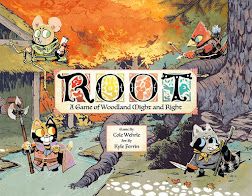Root - An Introduction
Game Specs
- Advertised Player Count: 1-4
- *Actual* Player Count: If you're going to play with only 1 player, you'll need the Clockwork expansion; if you're going to play with 2 players, you'll want the Clockwork expansion so there are some automated opponents. Otherwise, you really want 3-4. That's your sweet spot to see how the different factions interact with one another
- Playing Time: 60-90 minutes (I think this can be accurate, but if you have even one player who is new-ish to the game, or you've got players using some factions they've never used before, it's very likely to run longer)
- Age: 10+
- Premise: It's an asymmetrical war game wherein each player controls a different faction of forest critters.
I love the art they put in their games. I enjoy Vast, and am very much looking forward to Oath!
To that end, I've done my best to be so familiar with Root that I can easily answer questions about other factions, and then I need only check the rules for clarifications rather than basic rules. All of that aside, I really think the design is very, very good! Once you grasp the rules, I think you'll see the elegance of them and how each faction can implement exceptions to the rules, but the general rules of movement, combat, and crafting all do make sense as applied to each faction. Owing to the fact that the game is asymmetrical, that means gameplay is as well. That doesn't mean it isn't balanced! It just means that you have to have a basic understanding of the game in order to play with that balance. What does that mean? Well, it means it's easy to try and do what other players are doing to win, but that likely won't work for you because their faction scores differently than yours does. So there will be overlap between factions, but not so much that it will always be a race to the same ends in order to win.
I swear that the birds and cats are not the only factions in the game!
I won't lie: the game is sort of a lot of work. I say that because in order to play without folks helping one another, everyone really has to at least have a handle on their own faction. Then, they need to have a basic understanding of how the other factions score points and win the game. I say that because it's easy for the most knowledgeable player to spend all their time mitigating the player they think is the biggest threat because nobody else understands how quickly that faction can score points and take the lead. Take the Vagabond, for instance: whereas every other faction has an army of soldiers, the Vagabond has a single pawn. That's it. The Vagabond player does not have an army, and can never control a clearing. So how do they win? Well, they score VP, just like anyone else. They do this through giving others Aid, destroying enemy tokens, completing Quests, and Crafting.
If you've never played as the Vagabond or against it, you have no idea what Aid or Quests are. Fair enough. The crafting, though, is where things can get tricky. There are 9 different Vagabonds from which to choose, and each begins with different gear and has a different special ability. It's really cool! But if you're unfamiliar with how that particular Vagabond works, they will likely surprise you. The Tinker is an absolutely brutal opponent. It doesn't start with a crossbow or sword, and it may go the whole game without entering combat. So why is it a threat? Because it can Craft more quickly than any other Vagabond, and before you know it, they hit an 11 or 13 point turn to leap out to a ridiculous lead. If you didn't know they could do that, by the time they've done it, you're likely already out of the game.
So! None of this is to put you off of the game! It's just that I really, really enjoy the game while acknowledging that you really need to have an extremely solid handle on each faction in order to teach it. And even then, anticipate some bumps in the road as other players need to catch up with your knowledge before they're particularly effective at playing the game and not making decisions that end up screwing over everyone but some opposing player who happened to be the right faction to take advantage of such a blunder.
I think the game's components, theme, and mechanics are really cool, and if you like mid to heavy games, then this deserves a place in your collection. I think it's well-balanced, each faction brings a lot to the table, and the game has a lot to offer. There's also an app which allows you to play the base game on your phone, and it's great; really true to the board game! I'm just saying it requires some investment of your time and energy in order to really pay dividends and be revealed as the good game that it is.



Comments
Post a Comment